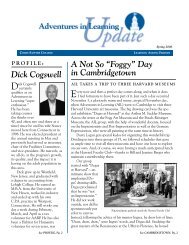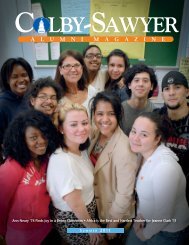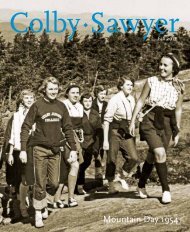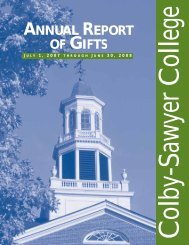A L U M N I M A G A Z I N E - Colby-Sawyer College
A L U M N I M A G A Z I N E - Colby-Sawyer College
A L U M N I M A G A Z I N E - Colby-Sawyer College
Create successful ePaper yourself
Turn your PDF publications into a flip-book with our unique Google optimized e-Paper software.
Firearms, knives, and baseball bats are only some of the weapons Kim has processed in her serology lab.<br />
behavior. You would think it might wear her down emotionally,<br />
but Kim rejects that thought. “When we go to a crime<br />
scene,” she says, “yes, we may be walking into something<br />
that’s horribly gross, bloodstained and miserable, but I<br />
approach each crime scene now as if I’m looking at pieces of a<br />
puzzle. I just want to figure out how everything fits into place.<br />
I’ll see different patterns in different rooms, and I’ll picture in<br />
my mind the scenarios that might have taken place. What’s<br />
rewarding is when you can piece together what happened at<br />
a particular scene from what you’ve observed. Maybe you can<br />
tell that a suspect is lying about committing a crime in self<br />
defense because of the way the bloodshed event is evidenced<br />
on the walls or floor. Or maybe you discover a piece of hardto-spot<br />
evidence that will help nail the lid shut on a criminal.”<br />
Kim finds it most satisfying that she can work on crime by<br />
solving puzzles from start to finish. Unlike many in her field<br />
who are more specialized, Kim can go from the crime scene to<br />
doing the serology work and then take it to DNA. “I like having<br />
the ability to put all of the pieces together and then, hopefully,<br />
seeing a completed picture. You have to have a passion for<br />
your job. In every unit in the lab, whether it’s fingerprinting,<br />
firearms, computers or the drug section, the thing that gives<br />
people the strength they need is their passion for the job,<br />
wanting to solve their part of the puzzle. It’s simply a love for<br />
what you do. It’s also the challenge because just as technology<br />
advances to help us in the lab, the bad guys are using it to help<br />
themselves as well.”<br />
For now, Kim is perfectly happy as a puzzle-solver, but<br />
she has other interests that she may pursue in the future. She<br />
teaches about blood spatter, serology and DNA at local high<br />
schools, and she feels when she’s ready to retire she may do<br />
more of this, as well as consult on forensic science. And then,<br />
of course, there’s always that book that needs to be written,<br />
which might start something like this:<br />
It’s a pitch black night and I’m standing in the bathroom of an isolated farm<br />
at the end of a long dirt road. The farm belongs to Sheila LaBarre, a suspected<br />
serial killer. The window is open to let in fresh air, and I can hear<br />
the crickets chirping. Other than that hypnotic sound, the night is<br />
still, and the inky blackness presses heavily through the window.<br />
I’m accompanied by a photographer and a police officer, but we<br />
don’t speak. I begin to spray the shower stall with luminol.<br />
As I spray, eerily glowing areas of blue phosphorescence emerge<br />
from the darkness. This is where blood has run, where a<br />
bloody handprint has been left, where a blood spatter<br />
pattern shows itself. Each of us feels the hair rising<br />
on our arms and the back of our necks. Each of us sucks in<br />
our breath with a low whoosh as these creepy vestiges of crime<br />
begin to appear. The blue glow brings forth answers no longer in<br />
hiding, as well as a haunting, chilling echo of past violence. ■<br />
WINTER 2010 21









